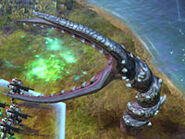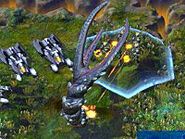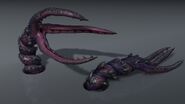m (seems like lua files agree with the original table) Tag: sourceedit |
(→History: clean up, typos fixed: Collossus → Colossus) Tag: apiedit |
||
| Line 9: | Line 9: | ||
Colossal alien unit. Siege worms can attack units and cities directly, as well as passively destroy terrain improvements as it moves. |
Colossal alien unit. Siege worms can attack units and cities directly, as well as passively destroy terrain improvements as it moves. |
||
===History=== |
===History=== |
||
| − | Vermis Obsidione |
+ | Vermis Obsidione Colossus |
Known colloquially as the “Siege Worm” or “drillworm”, this member of the Annelida phylum is segmented, tube-shaped and far larger than its Earth counterparts. Specimens of Vermis Obsidione have been found to average 400-600 meters in length and weigh up to 651935 metric tons. It is speculated that there are even larger and heavier Siege Worms living farther below the planetary surface. Thus far, however, all encounters with this species have been within 200 meters of the surface. |
Known colloquially as the “Siege Worm” or “drillworm”, this member of the Annelida phylum is segmented, tube-shaped and far larger than its Earth counterparts. Specimens of Vermis Obsidione have been found to average 400-600 meters in length and weigh up to 651935 metric tons. It is speculated that there are even larger and heavier Siege Worms living farther below the planetary surface. Thus far, however, all encounters with this species have been within 200 meters of the surface. |
||
Revision as of 21:30, 8 August 2016

Siege Worm Icon
Siege Worm
 Movement: 1
Movement: 1 Strength: 62
Strength: 62
Civilopedia entry
Game Information
Colossal alien unit. Siege worms can attack units and cities directly, as well as passively destroy terrain improvements as it moves.
History
Vermis Obsidione Colossus
Known colloquially as the “Siege Worm” or “drillworm”, this member of the Annelida phylum is segmented, tube-shaped and far larger than its Earth counterparts. Specimens of Vermis Obsidione have been found to average 400-600 meters in length and weigh up to 651935 metric tons. It is speculated that there are even larger and heavier Siege Worms living farther below the planetary surface. Thus far, however, all encounters with this species have been within 200 meters of the surface.
Like most annelids, Siege Worms have a digestive system that runs through the length of its body, a coelomic fluid system, a hydrostatic skeleton, and are able to move through even dense soil by means of the contraction of powerful circular muscles. To help in subsurface locomotion, each segment except the armored head has a ring of S-shaped setae embedded in the epidermal pit; unlike their smaller Earth cousins, these are arranged in a spiral pattern which facilitates breaking through rock and hard strata, giving the beast the nickname of “drillworm.” Passage can be surprisingly rapid, aided by the secretion of lubricating mucus.
The Siege Worm lives on organic matter, both living and dead, and requires at least one-third of its body weight per day to survive. The front segment, longer than the others, is able to open trilaterally with each portion having a row of chitin-like, backward-facing hooks. When moving, the worm scoops in large portions of soil, along with any organics within or upon the soil when it surfaces. After being pushed through the buccal cavity and esophagus, the material passes into a gizzard-like organ where muscular contractions grind the mass into fine particles, before passing into the intestines where pepsin, lipase and cellulose digest the proteins, fats and cellulose.
Having no organs of sight, Vermis Obsidionea possesses light- and touch-sensitive organs along their body which distinguish light intensity and amplify vibrations in the soil. They also have specialized chemoreceptors found in the head which react to chemical and scent stimuli. Due to these sense organs, the worms are drawn to strong vibrations and concentrations of organic matter, which has led to seeming “attacks” on colonial mining operations, farming endeavors and even settlements.
Strategy
Notes: Siege worms are roving monsters that are not initially indifferent to humanity, but may inadvertently pillage your improvements through their activities. Those who learn the ways of the worm (Harmony) may be able to use them for their own purposes, such as attracting them to their enemies' cities with a covert ops "Call Worm Strike " (Dune-style thumpers).
"When you kill the siege worm, you see its skull, and when you pick the skull up you may find a new quest thread that you can pick up and follow, and each time you complete an objective in that thread, you get a little bit of the fiction." - Will Miller






